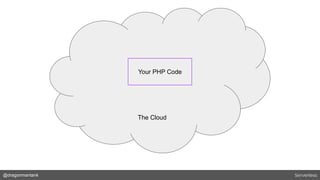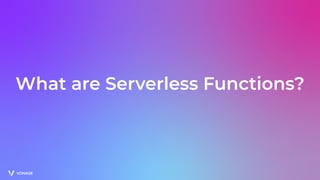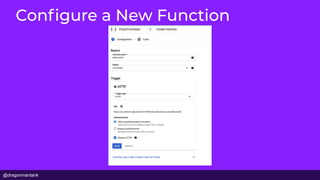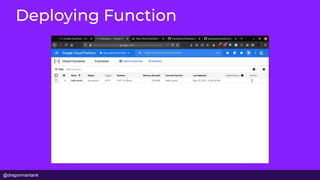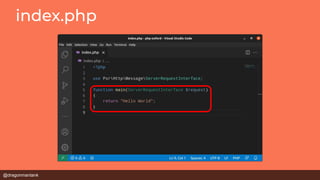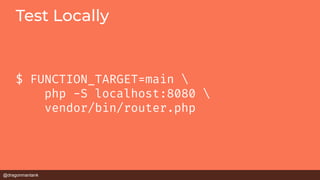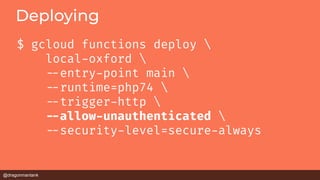Using PHP Functions! (Not those functions, Google Cloud Functions)
- 1. @dragonmantank Using PHP Functions! (not those functions, Google Cloud Functions) PRESENTED BY: Chris Tankersley Senior PHP Developer Advocate @dragonmantank
- 2. @dragonmantank What are Serverless Functions?
- 3. @dragonmantank What are is Serverless Functions?
- 4. @dragonmantank Traditional PHP Application Web Server
- 5. @dragonmantank Traditional PHP Application Web Server Your PHP Code
- 6. @dragonmantank A Server Traditional PHP Application Web Server Your PHP Code
- 7. @dragonmantank A Server Traditional PHP Application Web Server Microservice A Server Web Server Microservice A Server Web Server Microservice
- 10. @dragonmantank Serverless The Cloud Your PHP Code
- 11. @dragonmantank Serverless Your PHP Code
- 12. @dragonmantank Serverless Your PHP Code Your PHP Code Your PHP Code Your PHP Code Your PHP Code Your PHP Code Your PHP Code
- 14. @dragonmantank What are Serverless Functions?
- 15. @dragonmantank Function Dictionary Time A piece of code that takes one or more inputs, processes some logic, and may or may not return a value
- 16. @dragonmantank Functions Example Time // Top level functions function add( int $one, int $two ) { return $one + $two; } // Variable functions $func = function( int $one, int $two ) { return $one + $two; }
- 17. @dragonmantank Functions Example Time // Top level functions function add( int $one, int $two ) { return $one + $two; } // Variable functions $func = function( int $one, int $two ) { return $one + $two; }
- 18. @dragonmantank What are Serverless Functions?
- 19. @dragonmantank Serverless Your PHP Function Your PHP Function Your PHP Function Your PHP Function Your PHP Function Your PHP Function Your PHP Function
- 20. @dragonmantank Google Cloud Functions Newest kid on the block
- 21. @dragonmantank
- 22. @dragonmantank
- 23. @dragonmantank
- 24. @dragonmantank Create a New Project $ gcloud projects create php-oxford-9181984
- 25. @dragonmantank Create a New Project
- 26. @dragonmantank
- 27. @dragonmantank Create a New Function
- 28. @dragonmantank Configure a New Function
- 29. @dragonmantank Configure a New Function
- 30. @dragonmantank Configure a New Function
- 37. @dragonmantank Accessing the Function $ gcloud functions describe hello-world
- 40. @dragonmantank What Makes This Tick?
- 41. @dragonmantank What makes up a function? ● index.php ● Entry Method ● composer.json
- 42. @dragonmantank What Makes This Tick? $ mkdir php-oxford $ cd php-oxford $ composer require google/cloud-functions-framework
- 45. @dragonmantank Test Locally $ FUNCTION_TARGET=main php -S localhost:8080 vendor/bin/router.php
- 46. @dragonmantank Test Locally $ FUNCTION_TARGET=main php -S localhost:8080 vendor/bin/router.php
- 47. @dragonmantank Test Locally $ FUNCTION_TARGET=main php -S localhost:8080 vendor/bin/router.php
- 48. @dragonmantank Test Locally $ FUNCTION_TARGET=main php -S localhost:8080 vendor/bin/router.php
- 50. @dragonmantank Deploying $ gcloud functions deploy local-oxford /-entry-point main /-runtime=php74 /-trigger-http /-allow-unauthenticated /-security-level=secure-always
- 51. @dragonmantank Deploying $ gcloud functions deploy local-oxford /-entry-point main /-runtime=php74 /-trigger-http /-allow-unauthenticated /-security-level=secure-always
- 52. @dragonmantank Deploying $ gcloud functions deploy local-oxford /-entry-point main /-runtime=php74 /-trigger-http /-allow-unauthenticated /-security-level=secure-always
- 53. @dragonmantank Deploying $ gcloud functions deploy local-oxford /-entry-point main /-runtime=php74 /-trigger-http /-allow-unauthenticated /-security-level=secure-always
- 54. @dragonmantank Deploying $ gcloud functions deploy local-oxford /-entry-point main /-runtime=php74 /-trigger-http /-allow-unauthenticated /-security-level=secure-always
- 55. @dragonmantank Deploying $ gcloud functions deploy local-oxford /-entry-point main /-runtime=php74 /-trigger-http /-allow-unauthenticated /-security-level=secure-always
- 56. @dragonmantank Deploying $ gcloud functions deploy local-oxford /-entry-point main /-runtime=php74 /-trigger-http /-allow-unauthenticated /-security-level=secure-always
- 57. @dragonmantank Deploying $ gcloud functions deploy local-oxford /-entry-point main /-runtime=php74 /-trigger-http /-allow-unauthenticated /-security-level=secure-always
- 60. @dragonmantank Something a bit more real-world Demo Time
- 61. @dragonmantank Deploying $ composer require vonage/client lcobucci/jwt:^3.4
- 62. @dragonmantank Write an Answer Webhook
- 63. @dragonmantank Write an Answer Webhook
- 64. @dragonmantank Write an Answer Webhook
- 66. @dragonmantank Deploying $ vonage app:update 4ec8b8c1-4ba0-4644-bd8f-173d85ce2b40 /-voice_answer_url=https://us-central1-php-oxford-9 181984.cloudfunctions.net/oxford-demo
- 67. @dragonmantank Deploying $ vonage app:update 4ec8b8c1-4ba0-4644-bd8f-173d85ce2b40 /-voice_answer_url=https://us-central1-php-oxford-9 181984.cloudfunctions.net/oxford-demo
- 68. @dragonmantank Deploying $ vonage app:update 4ec8b8c1-4ba0-4644-bd8f-173d85ce2b40 /-voice_answer_url=https://us-central1-php-oxford-9 181984.cloudfunctions.net/oxford-demo
- 69. @dragonmantank Deploying $ vonage app:update 4ec8b8c1-4ba0-4644-bd8f-173d85ce2b40 /-voice_answer_url=https://us-central1-php-oxford-9 181984.cloudfunctions.net/oxford-demo
- 70. @dragonmantank Try Calling UK: (+44) 7520645746 US: (+1) 8003819125
- 71. @dragonmantank Resources ● General Documentation https://cloud.google.com/appengine/docs/standard/php7/runtime ● Service Information https://cloud.google.com/functions
- 72. 72 Chris Tankersley Senior PHP Developer Advocate at Vonage @dragonmantank [email protected]










